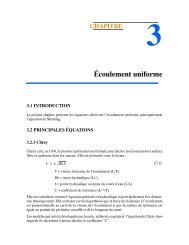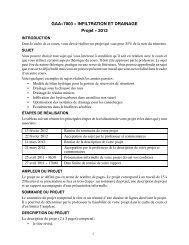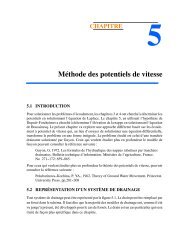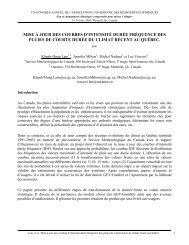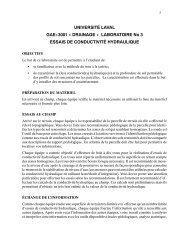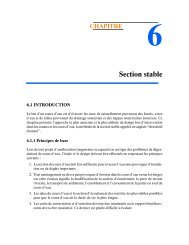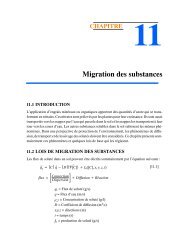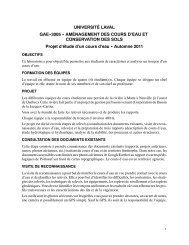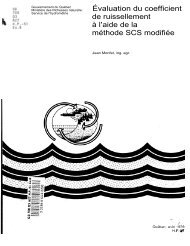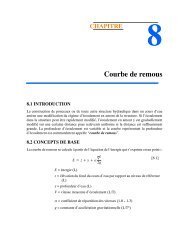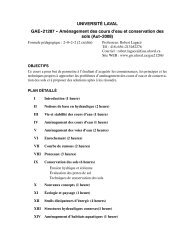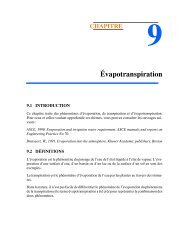CH-5 Courbe de remous
CH-5 Courbe de remous
CH-5 Courbe de remous
You also want an ePaper? Increase the reach of your titles
YUMPU automatically turns print PDFs into web optimized ePapers that Google loves.
68 COURBE DE REMOUS<br />
5.4 CANAL TRAPÉZOÏDAL<br />
Dans le cas du canal trapézoïdal, qui est le cas le plus fréquent, les paramètres suivants peuvent<br />
être définis :<br />
A(y) = (b + z y) y = b y + z y 2 [5.15]<br />
P(y) = b + 2 y 1 + z 2<br />
[5.16]<br />
R h<br />
= A (y)<br />
P(y) =<br />
( b + z y) y<br />
[5.17]<br />
b + 2 y 1 + z 2<br />
S f = f 1<br />
(y) = Q2 n 2 Q 2 n 2 b + 2 y 1 + z 2<br />
A 2 (y)<br />
43<br />
R = h<br />
43<br />
[5.18]<br />
[(b + z y) y] 103 [5.19]<br />
dA(y)<br />
dy<br />
= b + 2 z y<br />
f 2<br />
(y) =<br />
Q2<br />
g A 3 (y)<br />
dA(y)<br />
dy<br />
= Q2 (b + 2 z y)<br />
[(b + z y) y] 3<br />
[5.20]<br />
Après substitution, l’équation [5.14] s’écrit :<br />
dy<br />
dx = f 1 ( y) − S o<br />
1 − f 2<br />
(y)<br />
[5.21]<br />
5.5 CALCUL DE LA COURBE DE REMOUS<br />
À partir <strong>de</strong> l’équation d’Euler explicite, la courbe <strong>de</strong> <strong>remous</strong> peut être calculée par différnces<br />
finies en connaissant la profon<strong>de</strong>ur d’eau en une section <strong>de</strong> référence.<br />
y x+∆x<br />
= y x + ∆x dy<br />
dx x<br />
y x+∆x<br />
= y x + ∆x f 1 ( y x<br />
) − S o<br />
1 − f 2<br />
(y x<br />
)<br />
[5.22]<br />
[5.23]<br />
Pour améliorer la prédiction, une correction est effectuée en utilisant la métho<strong>de</strong> <strong>de</strong> Crank -<br />
Nicholson modifiée :<br />
y x+∆x = y x + ∆xα dy<br />
dx x + (1 − α) dy<br />
dx x+∆x<br />
[5.24]



